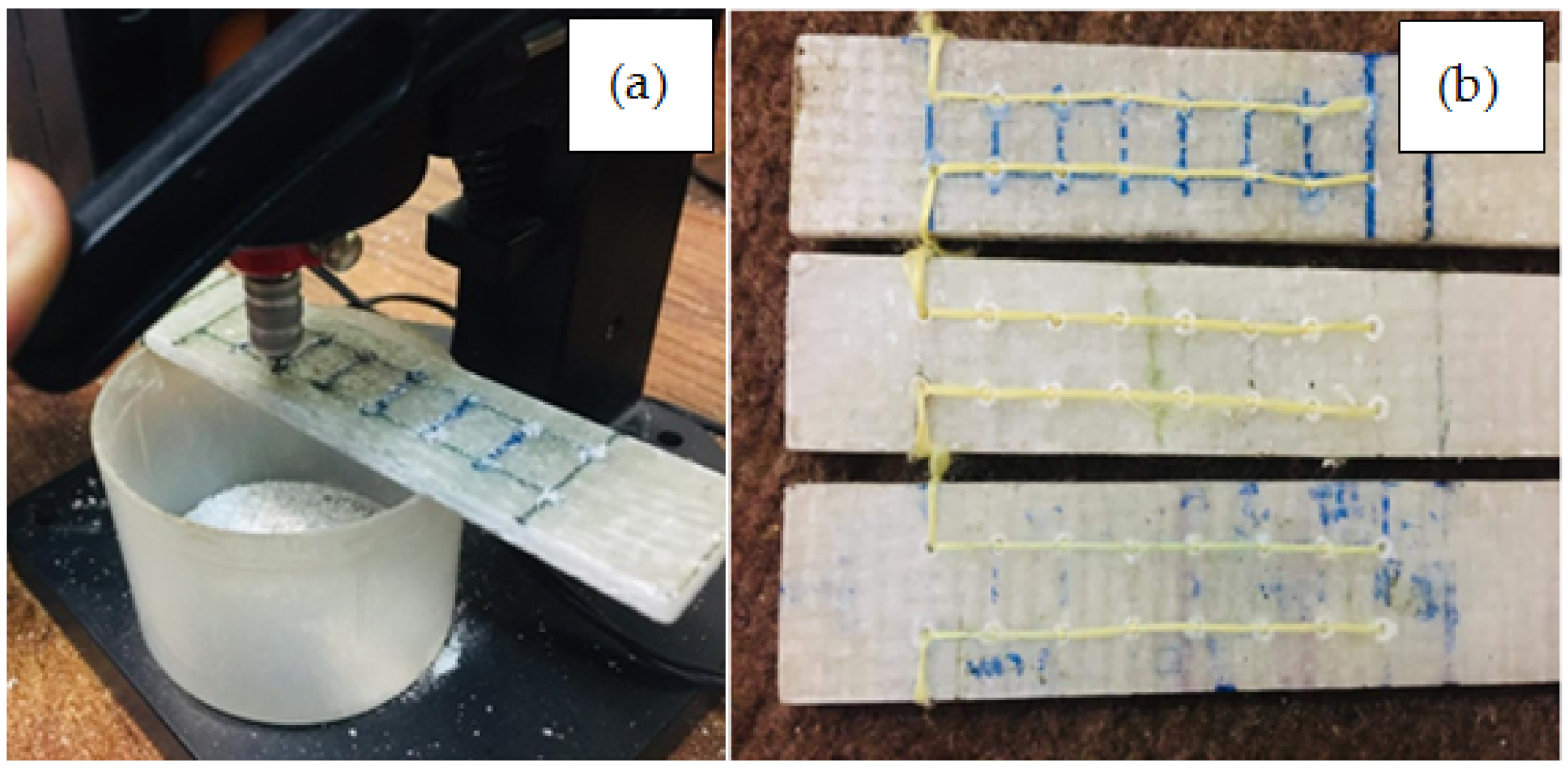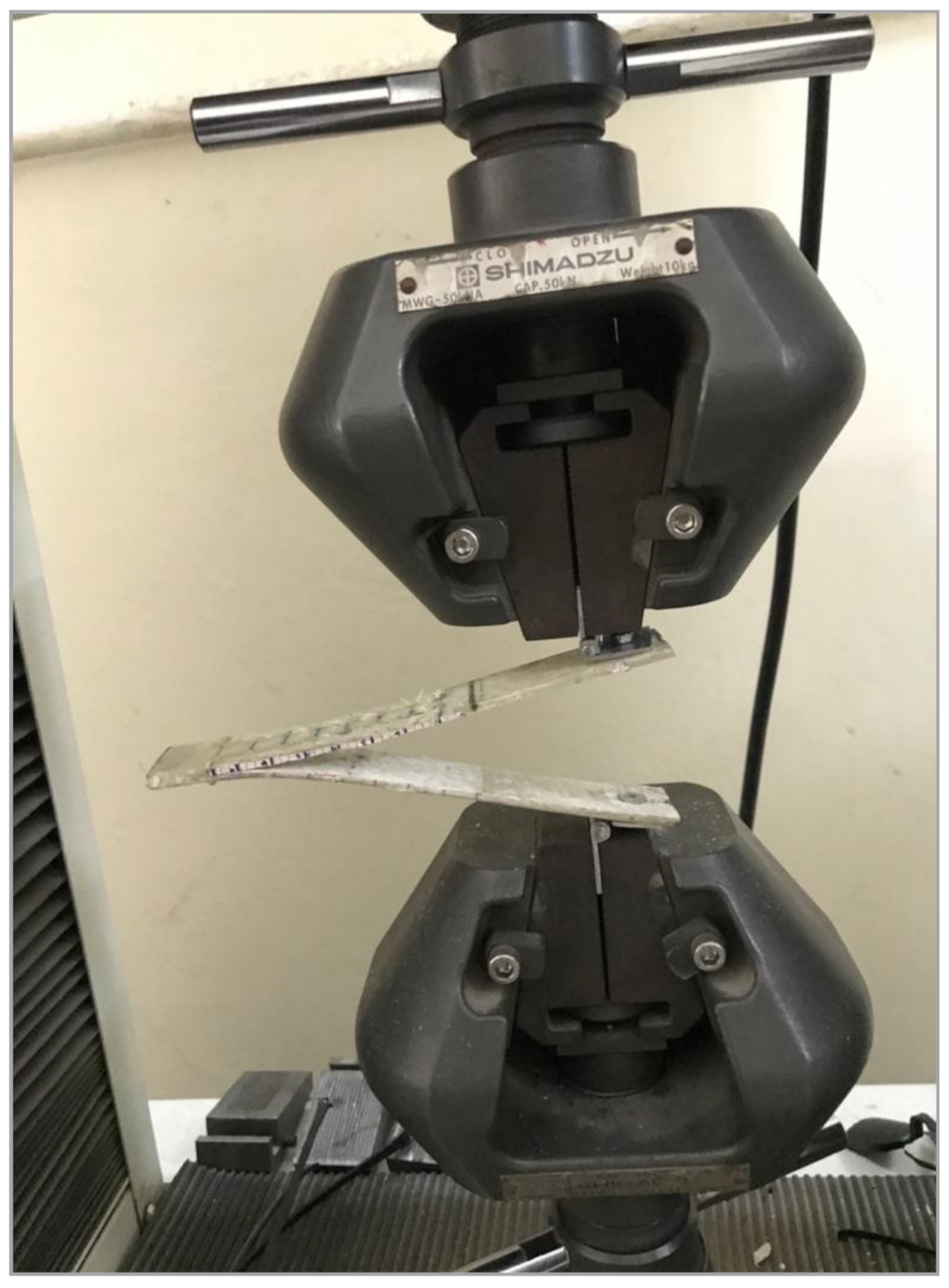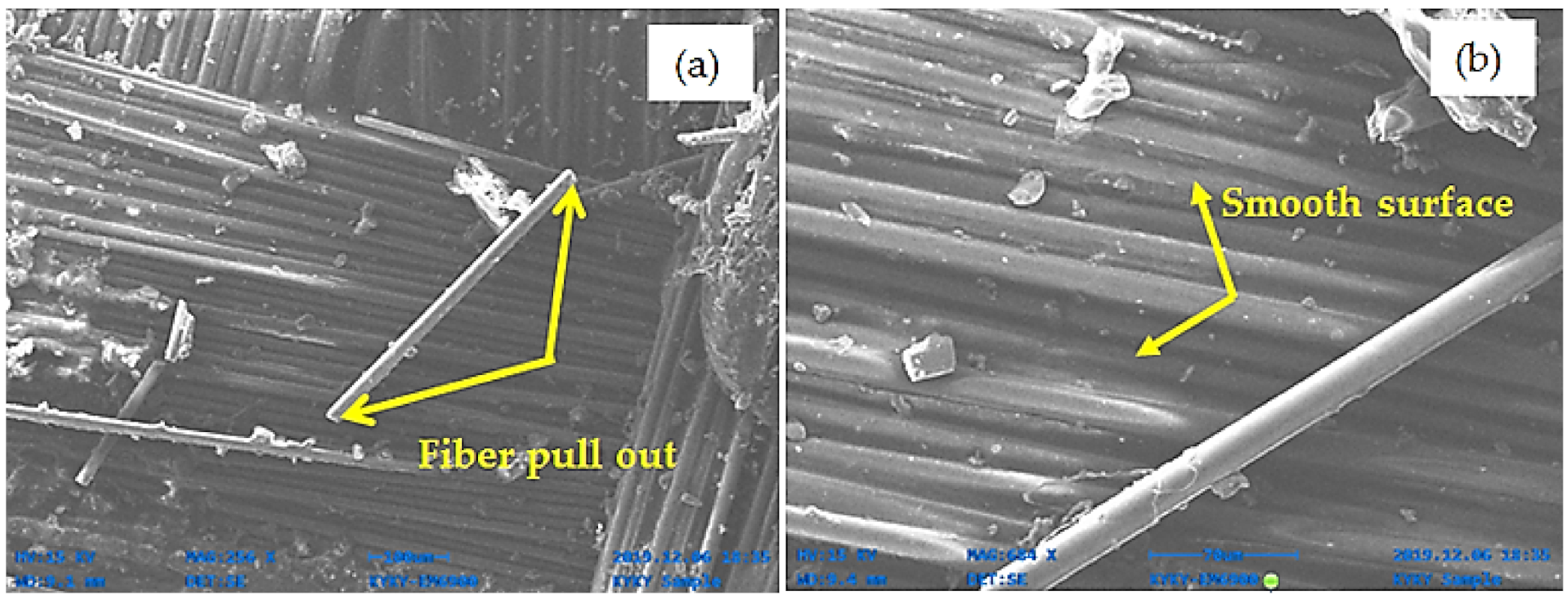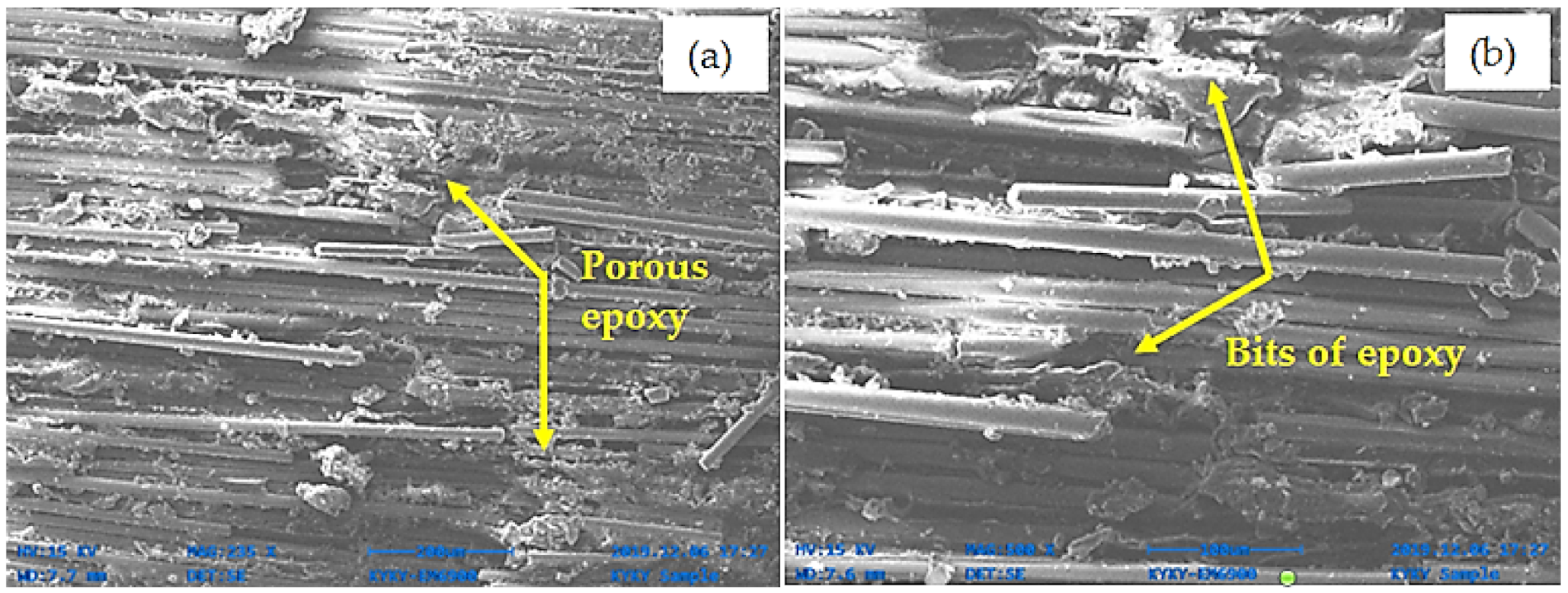Effect of Seawater Ageing on Fracture Toughness of Stitched Glass Fiber/Epoxy Laminates for Marine Applications
Abstract
:1. Introduction
2. Materials and Methods
3. Results
3.1. Loads versus Opening Displacement
3.2. Inter-Laminar Fracture Toughness
3.3. Fracture Mechanism Analyses and Effect of Water Ageing on Mass
4. Conclusions
Author Contributions
Funding
Institutional Review Board Statement
Informed Consent Statement
Data Availability Statement
Conflicts of Interest
References
- Fragassa, C. Marine applications of natural fibre-reinforced composites: A manufacturing case study. In Advances in Applications of Industrial Biomaterials; Springer: Cham, Switzerland, 2017; pp. 21–47. [Google Scholar] [CrossRef]
- Aamir, M.; Tolouei-Rad, M.; Giasin, K.; Nosrati, A. Recent advances in drilling of carbon fiber-reinforced polymers for aerospace applications: A review. Int. J. Adv. Manuf. Technol. 2019, 105, 2289–2308. [Google Scholar] [CrossRef]
- Ud Din, I.; Tu, S.; Hao, P.; Panier, S.; Khan, K.A.; Umer, R.; Shah, S.Z.H.; Franz, G.; Aamir, M. Sequential damage study induced in fiber reinforced composites by shear and tensile stress using a newly developed Arcan fixture. J. Mater. Res. Technol. 2020, 9, 13352–13364. [Google Scholar] [CrossRef]
- Ud Din, I.; Hao, P.; Panier, S.; Khan, K.A.; Aamir, M.; Franz, G.; Akhtar, K. Design of a new Arcan fixture for in-plane pure shear and combined normal/shear stress characterization of fiber reinforced polymer composites. Exp. Tech. 2020, 44, 231–240. [Google Scholar] [CrossRef]
- Ismail, S.O.; Sarfraz, S.; Niamat, M.; Mia, M.; Gupta, M.K.; Pimenov, D.Y.; Shehab, E. Comprehensive study on tool wear during machining of fiber-reinforced polymeric composites. In Machining and Machinability of Fiber Reinforced Polymer Composites; Springer: Singapore, 2020; pp. 129–147. [Google Scholar] [CrossRef]
- Guen-Geffroy, L.; Davies, P.; Le Gac, P.-Y.; Habert, B. Influence of seawater ageing on fracture of carbon fiber reinforced epoxy composites for ocean engineering. Oceans 2020, 1, 198–214. [Google Scholar] [CrossRef]
- Boscato, G.; Mottram, J.T.; Russo, S. Dynamic response of a sheet pile of fiber-reinforced polymer for waterfront barriers. J. Compos. Constr. 2011, 15, 974–984. [Google Scholar] [CrossRef]
- Rubino, F.; Nisticò, A.; Tucci, F.; Carlone, P. Marine application of fiber reinforced composites: A review. J. Mar. Sci. Eng. 2020, 8, 26. [Google Scholar] [CrossRef] [Green Version]
- Afshar, A.; Liao, H.-T.; Chiang, F.-p.; Korach, C.S. Time-dependent changes in mechanical properties of carbon fiber vinyl ester composites exposed to marine environments. Compos. Struct. 2016, 144, 80–85. [Google Scholar] [CrossRef] [Green Version]
- Fawzy, A.S.; El-Askary, F.S.; Amer, M.A. Effect of surface treatments on the tensile bond strength of repaired water-aged anterior restorative micro-fine hybrid resin composite. J. Dent. 2008, 36, 969–976. [Google Scholar] [CrossRef]
- Assarar, M.; Scida, D.; El Mahi, A.; Poilâne, C.; Ayad, R. Influence of water ageing on mechanical properties and damage events of two reinforced composite materials: Flax–fibres and glass–fibres. Mater. Des. 2011, 32, 788–795. [Google Scholar] [CrossRef]
- Mourad, A.-H.I.; Abdel-Magid, B.M.; El-Maaddawy, T.; Grami, M.E. Effect of seawater and warm environment on glass/epoxy and glass/polyurethane composites. Appl. Compos. Mater. 2010, 17, 557–573. [Google Scholar] [CrossRef]
- Hodzic, A.; Kim, J.K.; Lowe, A.; Stachurski, Z.H. The effects of water aging on the interphase region and interlaminar fracture toughness in polymer–glass composites. Compos. Sci. Technol. 2004, 64, 2185–2195. [Google Scholar] [CrossRef]
- Yan, L.; Chouw, N. Effect of water, seawater and alkaline solution ageing on mechanical properties of flax fabric/epoxy composites used for civil engineering applications. Constr. Build. Mater. 2015, 99, 118–127. [Google Scholar] [CrossRef]
- Han, W.; Chen, S.; Campbell, J.; Zhang, X.; Tang, Y. Fracture toughness and wear properties of nanosilica/epoxy composites under marine environment. Mater. Chem. Phys. 2016, 177, 147–155. [Google Scholar] [CrossRef]
- Fang, Y.; Wang, K.; Hui, D.; Xu, F.; Liu, W.; Yang, S.; Wang, L. Monitoring of seawater immersion degradation in glass fibre reinforced polymer composites using quantum dots. Compos. Part B Eng. 2017, 112, 93–102. [Google Scholar] [CrossRef]
- Salleh, Z.; Taib, Y.; Hyie, K.M.; Mihat, M.; Berhan, M.; Ghani, M. Fracture toughness investigation on long kenaf/woven glass hybrid composite due to water absorption effect. Procedia Eng. 2012, 41, 1667–1673. [Google Scholar] [CrossRef] [Green Version]
- José-Trujillo, E.; Rubio-González, C.; Rodríguez-González, J. Seawater ageing effect on the mechanical properties of composites with different fiber and matrix types. J. Compos. Mater. 2019, 53, 3229–3241. [Google Scholar]
- Bagheri, R.; Marouf, B.T.; Pearson, R.A. Rubber-toughened epoxies: A critical review. Polym. Rev. 2009, 49, 201–225. [Google Scholar] [CrossRef]
- Ozdemir, N.G.; Zhang, T.; Hadavinia, H.; Aspin, I.; Scarpa, F. Glass fibre reinforced polymer composites toughened with acrylonitrile butadiene nanorubber. Compos. Part B Eng. 2016, 88, 182–188. [Google Scholar] [CrossRef] [Green Version]
- Adachi, T.; Osaki, M.; Araki, W.; Kwon, S.-C. Fracture toughness of nano-and micro-spherical silica-particle-filled epoxy composites. Acta Mater. 2008, 56, 2101–2109. [Google Scholar] [CrossRef]
- Hsieh, T.; Kinloch, A.; Masania, K.; Lee, J.S.; Taylor, A.; Sprenger, S. The toughness of epoxy polymers and fibre composites modified with rubber microparticles and silica nanoparticles. J. Mater. Sci. 2010, 45, 1193–1210. [Google Scholar] [CrossRef]
- Du, X.; Liu, H.-Y.; Xu, F.; Zeng, Y.; Mai, Y.-W. Flame synthesis of carbon nanotubes onto carbon fiber woven fabric and improvement of interlaminar toughness of composite laminates. Compos. Sci. Technol. 2014, 101, 159–166. [Google Scholar] [CrossRef]
- Rugg, K.; Cox, B.; Massabo, R. Mixed mode delamination of polymer composite laminates reinforced through the thickness by z-fibers. Compos. Part A Appl. Sci. Manuf. 2002, 33, 177–190. [Google Scholar] [CrossRef]
- Cartié, D.D.; Partridge, I.K. Delamination behaviour of Z-pinned laminates. In European Structural Integrity Society; Elsevier: Amsterdam, The Netherlands, 2000; Volume 27, pp. 27–36. [Google Scholar]
- Gellert, E.; Turley, D.M. Seawater immersion ageing of glass-fibre reinforced polymer laminates for marine applications. Compos. Part A Appl. Sci. Manuf. 1999, 30, 1259–1265. [Google Scholar] [CrossRef]
- Siriruk, A.; Penumadu, D.; Weitsman, Y.J. Effect of sea environment on interfacial delamination behavior of polymeric sandwich structures. Compos. Sci. Technol. 2009, 69, 821–828. [Google Scholar] [CrossRef]
- Tan, K.T.; Watanabe, N.; Iwahori, Y. Effect of stitch density and stitch thread thickness on low-velocity impact damage of stitched composites. Compos. Part. A Appl. Sci. Manuf. 2010, 41, 1857–1868. [Google Scholar] [CrossRef]
- Abdelal, N.R.; Donaldson, S.L. The effect of nylon and Kevlar stitching on the mode I fracture of carbon/epoxy composites. World Acad. Sci. Eng. Technol. Int. J. Mech. Aerosp. Ind. Mechatron. Manuf. Eng. 2018, 12, 255–260. [Google Scholar]
- Dransfield, K.; Baillie, C.; Mai, Y.-W. Improving the delamination resistance of CFRP by stitching—A review. Compos. Sci. Technol. 1994, 50, 305–317. [Google Scholar] [CrossRef]
- Active Standard ASTM D5528. Standard Test Method for Mode I Interlaminar Fracture Toughness of Unidirectional Fiber-Reinforced Polymer Matrix Composites; ASTM International: West Conshohocken, PA, USA, 2007. [Google Scholar]
- Ellyin, F.; Rohrbacher, C. Effect of aqueous environment and temperature on glass-fibre epoxy resin composites. J. Reinf. Plast. Compos. 2000, 19, 1405–1427. [Google Scholar] [CrossRef]








Publisher’s Note: MDPI stays neutral with regard to jurisdictional claims in published maps and institutional affiliations. |
© 2021 by the authors. Licensee MDPI, Basel, Switzerland. This article is an open access article distributed under the terms and conditions of the Creative Commons Attribution (CC BY) license (http://creativecommons.org/licenses/by/4.0/).
Share and Cite
Hassan, A.; Khan, R.; Khan, N.; Aamir, M.; Pimenov, D.Y.; Giasin, K. Effect of Seawater Ageing on Fracture Toughness of Stitched Glass Fiber/Epoxy Laminates for Marine Applications. J. Mar. Sci. Eng. 2021, 9, 196. https://doi.org/10.3390/jmse9020196
Hassan A, Khan R, Khan N, Aamir M, Pimenov DY, Giasin K. Effect of Seawater Ageing on Fracture Toughness of Stitched Glass Fiber/Epoxy Laminates for Marine Applications. Journal of Marine Science and Engineering. 2021; 9(2):196. https://doi.org/10.3390/jmse9020196
Chicago/Turabian StyleHassan, Atizaz, Rafiullah Khan, Numan Khan, Muhammad Aamir, Danil Yurievich Pimenov, and Khaled Giasin. 2021. "Effect of Seawater Ageing on Fracture Toughness of Stitched Glass Fiber/Epoxy Laminates for Marine Applications" Journal of Marine Science and Engineering 9, no. 2: 196. https://doi.org/10.3390/jmse9020196







